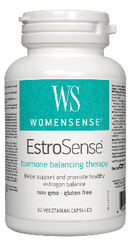NPN 80035630
Highlights
- Promotes healthy estrogen metabolism
- Helps maintain a healthy hormone balance
- Reduces the symptoms of estrogen dominance
- 60 Vegetarian Capsules
PAINFUL PERIODS? PMS?
Overview
EstroSense is a complete natural formula containing calcium D-glucarate, indole-3-carbinol, green tea extract, turmeric extract, rosemary extract, lycopene, sulforaphane, and milk thistle seed extract. Health care practitioners recommend EstroSense to help promote healthy estrogen metabolism. EstroSense is also a source of antioxidants for the maintenance of good health.
Recommended adult dose:
3 capsules once daily or as directed by a health care practitioner. Take with food. Use for a minimum of 3 weeks to see beneficial effects.
Nutrition
Every 3 vegetarian capsules contain
Medicinal Ingredients:
| Calcium D-Glucarate | 225 mg |
| Indole-3-Carbinol | 225 mg |
| Green Tea Extract (Camellia sinensis) (leaf) (80% Catechins, <1% Caffeine) | 150 mg |
| Turmeric Extract (Curcuma longa) (rhizome) (95% Curcuminoids) | 75 mg |
| Milk Thistle Extract (Silybum marianum) (seed) (60% Silymarin) | 75 mg |
| Rosemary Extract (Rosmarinus officinalis) (leaf) | 37.5 mg |
| Tomato Extract (Lycopersicon esculentum) (fruit) | 150 mg |
| Lycopene | 7.5 mg |
| Broccoli Powder (Brassica oleracea var. italica) (aerial) | 82.5 mg |
| Sulforaphane | 300 mcg |
Non-medicinal Ingredients:
Microcrystalline cellulose, vegetarian capsule (cellulose, purified water), vegetable grade magnesium stearate (lubricant), silica.
Studies
Studies
1. Dalessandri, K.M., Firestone, G.L., Fitch, M.D., et al. (2004). Pilot Study: Effect of 3,3’ – Diindolylmethane supplements on urinary hormone metabolites in postmenopausal women with a history of early-stage breast cancer. Nutrition and Cancer, 50(2), 161-167.
2. Lao, C.D., Ruffin, M.T., Normolle, D., et al. (2006). Dose escalation of a curcuminoid formulation. BMC Complimentary and Alternative Medicine, 6, 10.
3. Bell, M.C., Crowley-Nowick, P., Bradlow, H.L., et al. (2000). Placebo-controlled trial of Indole-3-Carbinol in the treatment of CIN. Gynecologic Oncology, 78, 123-129.
4. Reed, G.A., Peterson, K.S., Smith, H.J., et al. (2005). A Phase 1 study of Indole-3-Carbinol in women: tolerability and effects. Cancer Epidemiol Biomarkers, 14(8), 1953-1960.
5. Walaszek, Z., Hanausek, M., Narog, M., et al. (2004). Mechanisms of lung cancer chemoprevention by d-Glucarate. Chest, 125, 149S-150S.
6. Chow, H.H., Cai, Y., Hakim, I.A., et al. (2003). Pharmacokinetics and Safety of Green Tea Polyphenols after Multiple-Dose Administration of Epigallocatechin Gallate and Polyphenon E in Healthy Individuals. Clinical Cancer Research, 9, 3312-3319.
7. Cheung, C.W., Gibbons, N., Johnson, D.W., Nicol, D.L. (2010). Silibinin – a promising new treatment for cancer. Anticancer Agents Med. Chem, 10(3), 186-195.
8. Wang, H.J., Jiang, Y.Y., Wei, X.F., et al. (2010). Silibinin induces protective superoxide generation in human breast cancer MCF-7 cells. Free Radic Res, 44(1), 90-100.
9. Kim, S., Kim, S.H., Hur, S.M., et al. (2009). Silibinin prevents TPA-induced MMP-9 expression by down-regulation of COX-2 in human breast cancer cells. Journal of Ethnopharmacol, 126(2), 252-257.
10. Lin, C.J., Sukarieh, R., Peletier, J. (2009). Silibinin inhibits translation initiation: implications for anticancer therapy. Molecular Cancer Therapeutics, 8(6), 1606-1612.
11. Kim, S., Chol, J.H., Lim, H.I., et al. (2009). Silibinin prevents TPA-induced MMP-9 expression and VEGF secretion by inactivation of the Raf/MEK/ERK pathway in MCF-7 human breast cancer cells. Phytomedicine, 16(6-7), 573-580.
12. Wang, H.J., Tashiro, S., Onodera, S., Ikejima, T. (2008). Inhibition of insulin-like growth factor 1 receptor signaling enhanced silibinin-induced activation of death receptor and mitochondrial apoptotic pathways in human breast cancer MCF-7 cells. Journal of Pharmacological Sciences, 107(3), 260-269.
13. Verschoyle, R.D., Brown, K., Steward, W.P., Gescher, A.J. (2008). Consumption of silibinin, a flavonolignan from milk thistle, and mammary cancer development in the C3(1) SV40 T,t antigen transgenic multiple mammary adenocarcinoma (Tag) mouse. Cancer Chemotherapy and Pharmacology, 62(2), 369-372.
14. Raina, K., Agarwal, R. (2007). Combinatorial strategies for cancer eradication by silibinin and cytotoxic agents: efficacy and mechanisms. Acta Pharmacologica Sinica, 28(9), 1466-1475.
15. Lee, S.O., Jeong, Y.J., Im, H.G., et al. (2007). Silibinin suppresses OMA-induced MMP-9 expression by blocking the AP-1 activation via MAPK signaling pathways in MCF-7 human breast carcinoma cells. Biochemical and Biophysical Research Communications, 354(1), 165-171.
16. (2009) Milk Thistle [Monograph]. Retrieved from Health Canada Natural Health Products Ingredients Database
17. (2008) Rosemary – Oral [Monograph]. Retrieved from Health Canada Natural Health Products Ingredients Database
18. (2008) Turmeric – Oral [Monograph]. Retrieved from Health Canada Natural Health Products Ingredients Database
19. (2006) Calcium D-Glucarate [Monograph]. Retrieved from Natural Medicines Comprehensive Database
20. (2006) Lycopene [Monograph]. Retrieved from Natural Medicines Comprehensive Database
21. (2006) Sulforphane [Monograph]. Retrieved from Natural Medicines Comprehensive Database
References
1. Bradlow, H.L. et al. (1996). 2-hydroxyestrone: the ‘good’ estrogen. J Endocrinol, 150 Suppl: S259-65.
2. Degen, G.H. & Bolt, H.M. (2000). Endocrine disruptors: update on xenoestrogens. Int Arch Occup Health, 73, 433-441.
3. Muti, P., et al. (2000). Estrogen Metabolism and Risk of Breast Cancer: A Prospective Study of the 2:16α-Hydroxyestrone Ratio in Premenopausal and Postmenopausal Women. Epidemiology, Vol. 11, No. 6 (Nov., 2000), pp. 635-640.
4. Calcium D-Glucarate Monograph. (2002). Alternative Medicine Reviews, 7(4), 336-339.
5. Heerdt, A.S., Young, C.W., Borgen, P.I. (1995). Calcium glucarate as a chemopreventive agent in breast cancer. Isr J Med Sci, 31, 101-105.
6. Reed, G.A., et al. (2005). A Phase I Study of Indole-3-Carbinol in women: Tolerability and Effects. Cancer Epidemiol Biomarkers Prev, 14(8), 1953-1958.
7. Kim, H.J., et al. (2008). Nrf2 activation by sulforaphane restores the age-related decrease of TH1 immunity: Role of dendritic cells. The Journal of Allergy and Clinical Immunology, 121(5), 1255-1267.
8. Li, Y., et al. (2010). Sulforaphane, a dietary component of broccoli/broccoli sprouts, inhibits breast cancer stem cells. Clin Cancer Res, 16(9), 2580-90.
9. Pradhan, S.C. & Girish, C. (2006). Hepatoprotective Herbal Drug, Silymarin From Experimental Pharmacology to Clinical Medicine. Indian Journal of Medical Research, 2006.
10. Wu, A.H., et al. (2005). Tea and Circulating Estrogen Levels in Postmenopausal Chinese Women in Singapore. Carcinogenesis. May 2005.
Payment & Security
Your payment information is processed securely. We do not store credit card details nor have access to your credit card information.






